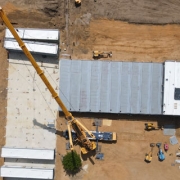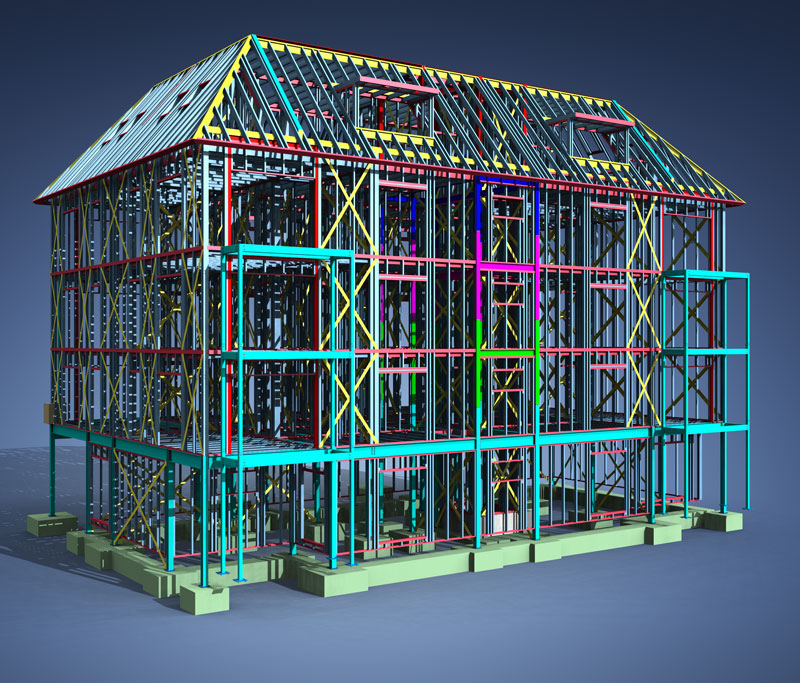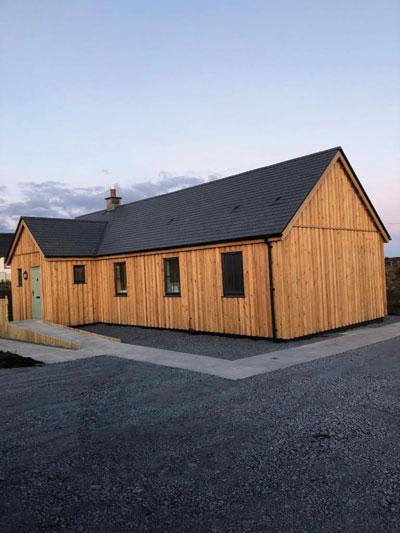The £12.7m school is the first school to be awarded to Portakabin
under the Department for Education’s (DfE) MMC1 framework.
Installation has completed in just two weeks for a brand new,
state-of-the-art 170-place special school outside Norwich.
CLICK BELOW to exclusive drone footage of how the installation unfolded here
The school will be part of The Bridge Multi Academy Trust and will be for children with learning and cognition needs from ages four to 19, is in the village of Easton and will provide purpose-built facilities including a forest school area and a specialist autism unit.
Constructed offsite using Modern Methods of Construction (MMC), the school building took shape in lightning speed, with all 60 modules in place in just two weeks. The custom modules have been designed specifically for the Department for Education. At 3.6m wide and 18.75m long, each module attains better thermal performance and offers improved day light for the comfort of both pupils and teachers.
Built by modular building market leaders Portakabin, the school was precision engineered in its manufacturing facility in York.
After starting on site in January, installation was completed in June and the project is on programme to complete in December 2022.
When the school opens it will have a growth plan with children admitted in a careful and planned way until it reaches capacity.
The completed site will include on-site staff and visitor parking, minibus and taxi drop-off points, sports pitches, a MUGA court, outdoor play areas, a forest school area and a productive garden.
Nick Griffin, Divisional MD for Portakabin comments: “This Norfolk special school is the first of many projects to be awarded to us on the DfE’s MMC1 framework.
“Our latest module development means we can offer modular schools with better learning environments thanks to larger windows, bigger classrooms and better thermal performance.
“Innovation in modular buildings continues to develop at pace and means we can provide a high quality and reliable alternative to traditional construction, something here at Portakabin we’re always excited to talk about!”
Cllr Daniel Elmer, deputy cabinet member for Norfolk’s Children’s Services, said: “Making the case for this school to be delivered as part of the DfE’s free school programme has been a key part of Norfolk County Council’s £120 million SEND transformation programme.
“We pledged to deliver at least 500 new places in specialist provision and this school is a huge part of that work.
“We can’t wait to see the different it makes to the lives of dozens of children and young people with SEND and their families.”
Dr Penny Barratt, CEO, The Bridge London Trust comments: “We at The Bridge MAT are extremely excited to be working with Norfolk County Council and the Department for Education to develop this new school, The Bridge Easton. We are aware of the need for additional special school places and are really looking forward to opening this school in Norfolk.”
The planned opening date is January 2023.
All places will be commissioned and funded by Norfolk County Council. New admissions will be through a county admissions panel. No waiting lists are in operation at this time.
Find out more about admission to special schools and specialist colleges here










 Vertex BD uses a high level of automation to rapidly reduce the time spent in the design phase, whilst giving its users the flexibility to build the way they need.
Vertex BD uses a high level of automation to rapidly reduce the time spent in the design phase, whilst giving its users the flexibility to build the way they need.
 The owners of this gorgeous new property decided to relocate to the Hebridean Isle of Islay for their retirement after falling in love with the island following a trip there many years ago and tasked the Wee House Company to build an off-site, bespoke modular home that fitted all of their unique requirements.
The owners of this gorgeous new property decided to relocate to the Hebridean Isle of Islay for their retirement after falling in love with the island following a trip there many years ago and tasked the Wee House Company to build an off-site, bespoke modular home that fitted all of their unique requirements.




 James Walsh, CEO of Studio Anyo, said as DfMA consultants, AnyOffsite’s knowledge of the supply chain is unparalleled, helping to ensure clients can secure best value for their projects and maximise return on investment in highly competitive markets.
James Walsh, CEO of Studio Anyo, said as DfMA consultants, AnyOffsite’s knowledge of the supply chain is unparalleled, helping to ensure clients can secure best value for their projects and maximise return on investment in highly competitive markets.
 One reason you’re not finding as many passionate, long-term employees may be that you’re not looking in the right places. The construction industry has historically been a highly male-dominated field, so women and other under-represented groups may feel discouraged from applying to apprenticeships or internship programmes in the first place. In fact, research by the Chartered Institute of Building found that the construction sector is still only 15% women (with only 2% on-site), 6% BAME workers, and 6% disabled workers (People Management). This means that many construction companies are missing out on a whole demographic of skilled young people due to a lack of representation the industry.
One reason you’re not finding as many passionate, long-term employees may be that you’re not looking in the right places. The construction industry has historically been a highly male-dominated field, so women and other under-represented groups may feel discouraged from applying to apprenticeships or internship programmes in the first place. In fact, research by the Chartered Institute of Building found that the construction sector is still only 15% women (with only 2% on-site), 6% BAME workers, and 6% disabled workers (People Management). This means that many construction companies are missing out on a whole demographic of skilled young people due to a lack of representation the industry.